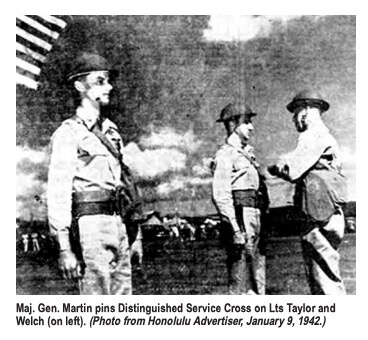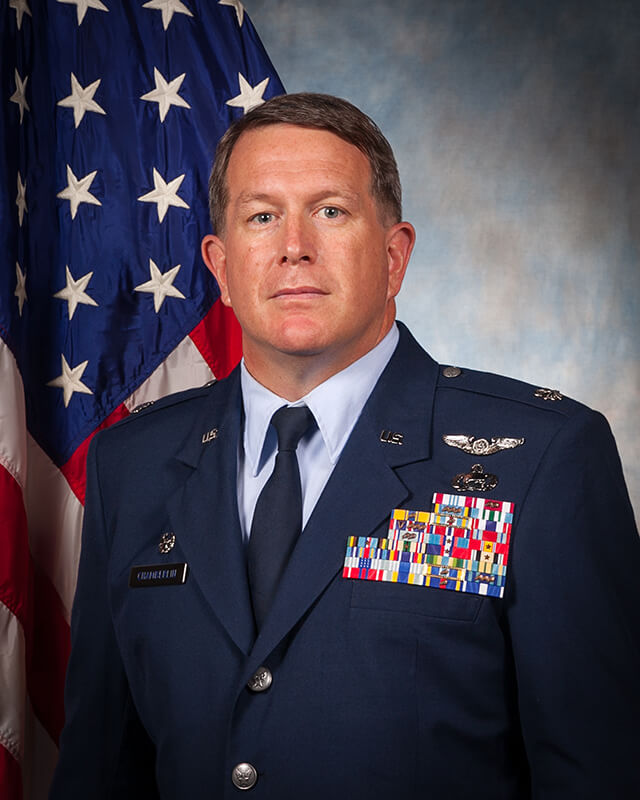May 19, 2020
Pearl Harbor and Purdue University: The parallels of two pioneer aviators
 One month after the attack on Pearl Harbor, two former Purdue Boilermakers, Maj. Gen. Frederick L. Martin and 2nd Lt. George S. Welch, met when Martin pinned Welch with the Distinguished Service Cross award, the United States’ second-highest decoration. (Provided photo)
One month after the attack on Pearl Harbor, two former Purdue Boilermakers, Maj. Gen. Frederick L. Martin and 2nd Lt. George S. Welch, met when Martin pinned Welch with the Distinguished Service Cross award, the United States’ second-highest decoration. (Provided photo)
WEST LAFAYETTE, Ind. — One month after the attack on Pearl Harbor, two former Purdue Boilermakers, Maj. Gen. Frederick L. Martin and 2nd Lt. George S. Welch, met when Martin pinned Welch with the Distinguished Service Cross award, the United States’ second-highest decoration.
Although the ceremony was the only definitive record that the two men met, Martin and Welch shared many other connections spanning multiple decades, including that both men earned the Distinguished Service Cross, died within months of one another and are buried within 500 yards of one another in Arlington National Cemetery.
The connections were uncovered by a Purdue doctoral history student, Lt. Col. John “Garick” Chamberlin, with the help of Michael Smith, a professor of history.
“What got me interested in these two individuals was the dichotomy between them,” Chamberlin said. “It’s fascinating that they both ended up following each other around even though they weren’t actually connected to each other. The parallels kept building as I did more research.”
Chamberlin is an active duty U.S. Air Force officer, pursuing his Ph.D. as part of the Air University Faculty Development program. He has been an Air Force member for 26 years, spending nine years enlisted and 17 years as an officer. He received a master’s in Middle East studies, taught Arabic at the Air Force Academy and commanded at the Air Force’s Squadron Officer School.
He is the current Air Force Institute of Technology liaison officer to Purdue. In the role, Chamberlin leads 20 Air Force graduate students and works with the Air Force ROTC program, Purdue’s Veterans Success Center and the Purdue Military Research Institute to support military-connected students. His research areas are modern Middle East history, medieval and crusades era history, United States and Middle East interaction and aviation history.
Chamberlin’s research on Martin and Welch recently was published in Air Power History magazine in an article he wrote titled “Pearl Harbor and Purdue University: Pioneer Aviators Seek What Lies Before.”
 John “Garick” Chamberlin. (Provided photo)
Download image
John “Garick” Chamberlin. (Provided photo)
Download image
Martin was born in 1882 in Liberty, Indiana. He enrolled in the School of Mechanical Engineering at Purdue in 1904. His background in engineering made him well suited to join the Coastal Artillery, assisting in integrating new weapons and calculating firing solutions to target moving ships. In 1920, Martin trained to be a pilot and began a series of commands in flight and technical training. These experiences, in part, paved the way for him to be chosen as a commander to fly one of the planes in the Army’s race to complete the first around-the-world flight. Martin’s aircraft and one other got lost in the attempt, but all fliers returned safely and all four crews received the Distinguished Service Cross for their efforts. By 1940, Martin was chosen to command the Hawaiian Air Force.
Welch was born in 1918 and came to Purdue from Wilmington, Delaware, in 1937 to enroll in mechanical engineering. He received his pilot’s license after formally training in a Purdue aviation course, then associated with the Civil Aeronautics Authority. While waiting to train with the Army Air Corps, Welch changed his major to science. A colleague speculated he made this decision to learn about meteorology and navigation portions. During his junior year, Welch left Purdue to join the Army Air Corps, earned his wings and was commissioned to Wheeler Field in Hawaii in January 1941.
Although Martin and Welch were both on the island the day Pearl Harbor was attacked, it went very differently for the two men. Martin, along with Navy aviation counterpart Adm. Patrick Bellinger, had correctly assessed eight months prior that the Japanese might enact a surprise attack without an official declaration of war, but the base hadn’t made plans operational yet. On the morning of the attack, Martin also suffered a chronic ulcer attack. By Dec. 17, the general and several other leaders were relieved of their command pending investigation. Spoiler alert: Welch was exonerated in the investigation and continued to serve.
In contrast, Welch experienced a high point of his career on Dec. 7. On his first run, Welch shot down one dive bomber. By the end of the day, Welch had been hit four times, including one at his engine and propeller. He shot down three more Japanese aircraft despite one jammed gun. Welch became a minor celebrity, being featured in at least 650 newspaper articles across the country in the span of two months. Welch joined a media and rally tour to recruit for the Air Corps. He wouldn’t return to action until a year to the day of Pearl Harbor in New Guinea, where he shot down three more planes and earned status as ace. By the end of 1943, he was among the top aces, reaching 16 confirmed victories.
To read the full story on Martin and Welch’s coincidental connections, visit Chamberlin’s article on pages 27-34 in Air Power History magazine.
About Purdue University
Purdue University is a top public research institution developing practical solutions to today’s toughest challenges. Ranked the No. 6 Most Innovative University in the United States by U.S. News & World Report, Purdue delivers world-changing research and out-of-this-world discovery. Committed to hands-on and online, real-world learning, Purdue offers a transformative education to all. Committed to affordability and accessibility, Purdue has frozen tuition and most fees at 2012-13 levels, enabling more students than ever to graduate debt-free. See how Purdue never stops in the persistent pursuit of the next giant leap at purdue.edu.
Writer: Madison Sanneman, msannema@purdue.edu
Media Contact: Joseph Paul, paul102@purdue.edu (working remotely but will provide immediate response)
Source: John “Garick” Chamberlin, chambe89@purdue.edu
Note to Journalists: A 1942 newspaper photograph capturing the meeting of Maj. Gen. Frederick L. Martin and 2nd Lt. George S. Welch and a photo of the history student who completed the research is available via a Google Drive folder.

